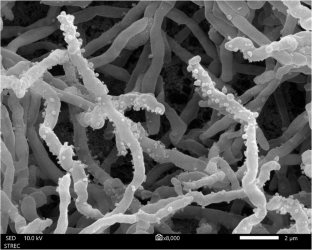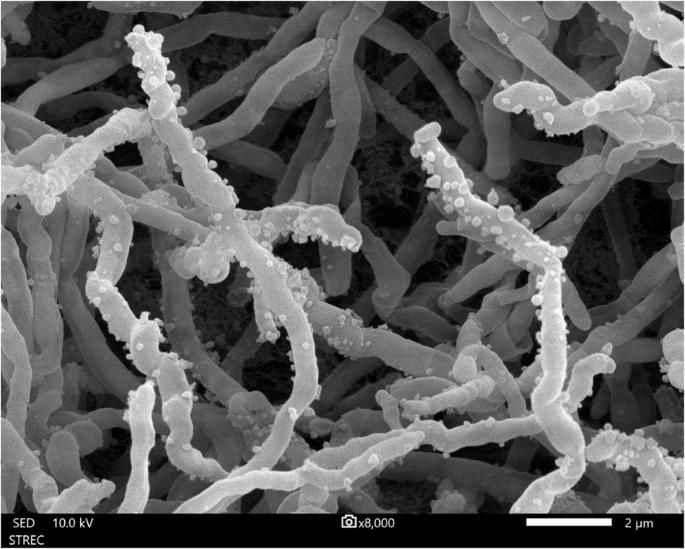Actinomycetospora termitidis sp. nov., an insect-derived actinomycete isolated from termite (Odontotermes formosanus)
IF 2.1
4区 医学
Q3 BIOTECHNOLOGY & APPLIED MICROBIOLOGY
引用次数: 0
Abstract
Strain Odt1-22T, an insect-derived actinomycete was isolated from a termite (Odontotermes formosanus) that was collected from Chanthaburi province, Thailand. Strain Odt1-22T was aerobic, Gram-stain-positive, and produced bud-like spore chain on the substrate hypha. According to chemotaxonomic analysis, strain Odt1-22T contained meso-diaminopimelic acid in peptidoglycan and the whole-cell hydrolysates contained arabinose, galactose, glucose, and ribose. The major menaquinone was MK-8(H4). The diagnostic phospholipids were diphosphatidylglycerol, hydroxyphosphatidylethanolamine, phosphatidylethanolamine and phosphatidylglycerol. Phylogenetic analysis based on 16 S rRNA gene sequence revealed that strain Odt1-22T was identified to the genus Actinomycetospora and showed high similarity values with A. chiangmaiensis DSM 45062 T (99.24%), A. soli SF1T (99.24%) and A. corticicola 014-5 T (98.17%). The genomic size of strain Odt1-22T was 6.6 Mbp with 73.8% G + C content and 6355 coding sequences (CDSs). The genomic analysis, strain Odt1-22T and closely related species A. chiangmaiensis DSM 45062 T, A. soli SF1T and A. corticicola DSM 45772 T displayed the values of average nucleotide identity-blast (ANIb) at 83.7–84.1% and MUMmer (ANIm) at 86.6–87.0%. Moreover, the results of digital DNA-DNA hybridization values between strain Odt1-22T and related Actinomycetospora species were 45.8−50.5% that lower than the threshold value of commonly used to delineate separated species level. On the basis of phenotypic, chemotaxonomic, and genotypic data, strain Odt1-22T represented a novel species within the genus Actinomycetospora, for which the name Actinomycetospora termitidis sp. nov. is proposed. The type strain of the species is Odt1-22T (= TBRC 16192 T = NBRC 115965 T).


白蚁放线菌(Actinomycetospora termitidis sp.)
从泰国尖竹汶府采集的白蚁(Odontotermes formosanus)中分离出了昆虫放线菌株 Odt1-22T。菌株 Odt1-22T 需氧,革兰氏染色阳性,在基质菌丝上产生芽状孢子链。根据化学分类学分析,菌株 Odt1-22T 的肽聚糖中含有中二氨基亚硒酸,全细胞水解物中含有阿拉伯糖、半乳糖、葡萄糖和核糖。主要的脑醌是 MK-8(H4)。诊断性磷脂是二磷脂酰甘油、羟基磷脂酰乙醇胺、磷脂酰乙醇胺和磷脂酰甘油。基于 16 S rRNA 基因序列的系统进化分析表明,菌株 Odt1-22T 被鉴定为放线菌属,与 A. chiangmaiensis DSM 45062 T(99.24%)、A. soli SF1T(99.24%)和 A. corticicola 014-5 T(98.17%)具有很高的相似度。菌株 Odt1-22T 的基因组大小为 6.6 Mbp,G + C 含量为 73.8%,编码序列(CDS)为 6355 个。经基因组分析,菌株 Odt1-22T 与近缘种 A. chiangmaiensis DSM 45062 T、A. soli SF1T 和 A. corticicola DSM 45772 T 的平均核苷酸同一性 Blast (ANIb) 值为 83.7-84.1%,MUMmer (ANIm) 值为 86.6-87.0%。此外,Odt1-22T菌株与相关放线菌之间的数字DNA-DNA杂交值为45.8%-50.5%,低于通常用于划分分离物种水平的阈值。根据表型学、化学分类学和基因型数据,菌株 Odt1-22T 代表了放线菌属中的一个新种,拟命名为白蚁放线菌 sp.nov.。该物种的模式菌株为 Odt1-22T(= TBRC 16192 T = NBRC 115965 T)。
本文章由计算机程序翻译,如有差异,请以英文原文为准。
求助全文
约1分钟内获得全文
求助全文
来源期刊

Journal of Antibiotics
医学-免疫学
CiteScore
6.60
自引率
3.00%
发文量
87
审稿时长
1 months
期刊介绍:
The Journal of Antibiotics seeks to promote research on antibiotics and related types of biologically active substances and publishes Articles, Review Articles, Brief Communication, Correspondence and other specially commissioned reports. The Journal of Antibiotics accepts papers on biochemical, chemical, microbiological and pharmacological studies. However, studies regarding human therapy do not fall under the journal’s scope. Contributions regarding recently discovered antibiotics and biologically active microbial products are particularly encouraged. Topics of particular interest within the journal''s scope include, but are not limited to, those listed below:
Discovery of new antibiotics and related types of biologically active substances
Production, isolation, characterization, structural elucidation, chemical synthesis and derivatization, biological activities, mechanisms of action, and structure-activity relationships of antibiotics and related types of biologically active substances
Biosynthesis, bioconversion, taxonomy and genetic studies on producing microorganisms, as well as improvement of production of antibiotics and related types of biologically active substances
Novel physical, chemical, biochemical, microbiological or pharmacological methods for detection, assay, determination, structural elucidation and evaluation of antibiotics and related types of biologically active substances
Newly found properties, mechanisms of action and resistance-development of antibiotics and related types of biologically active substances.
 求助内容:
求助内容: 应助结果提醒方式:
应助结果提醒方式:


